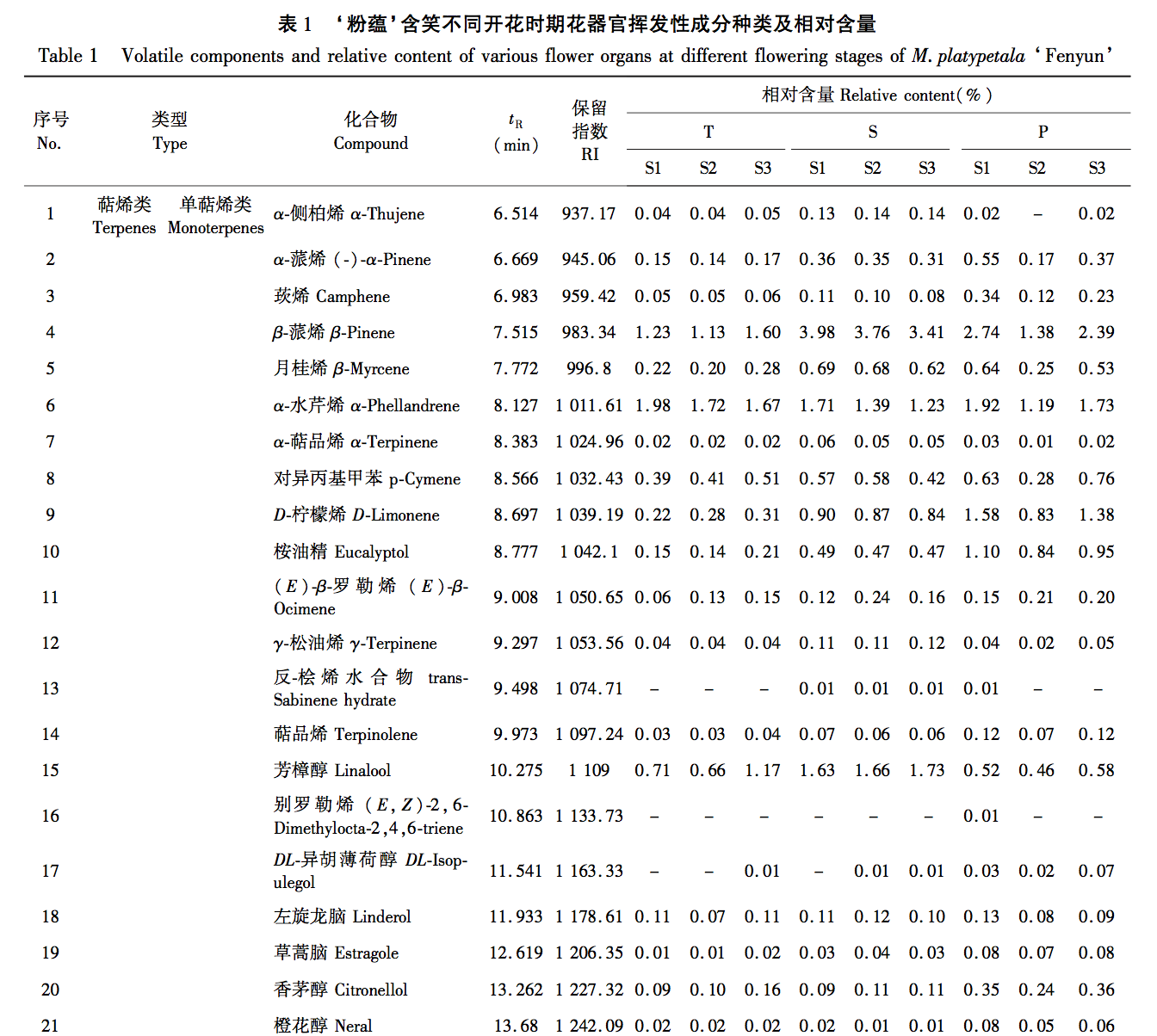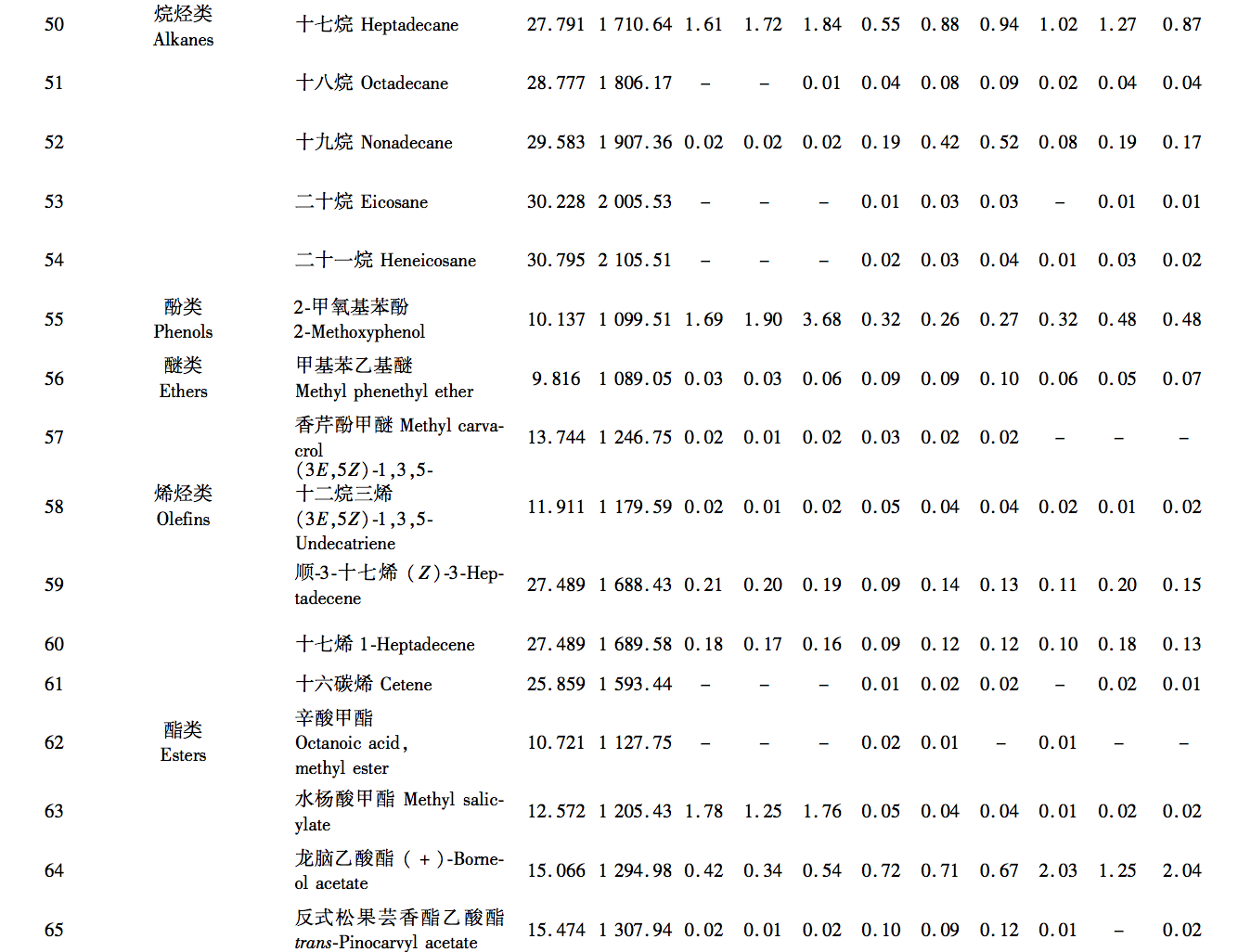HS-SPME-GC-MS Analysis of the Changes in Volatile Components of Flower Organs in ‘Fenyun’ Smiles at Different Flowering Stages
Floral fragrance refers to a complex mixture composed of a series of low molecular weight and highly volatile aromatic substances released from plant flowers. The appropriate concentration of floral fragrance has a positive impact on human physical and mental health. Therefore, floral fragrance is also known as the “soul of flowers” and is one of the important ornamental traits of plants. The main methods for extracting volatile components from flowers include distillation, organic solvent extraction, microwave-assisted extraction, supercritical CO2 extraction, headspace solid-phase microextraction (HS-SPME), and simultaneous distillation extraction. The headspace solid-phase microextraction method is widely used due to its advantages of simple operation, small sample size, low cost, wide application range, and accurate and reliable experimental results. The methods for determining volatile components in flowers include gas chromatography-mass spectrometry, gas chromatography ion mobility spectrometry, gas chromatography olfaction, and electronic nose technology. Gas chromatography-mass spectrometry (GC-MS) requires a small sample size, high sensitivity, and fast detection speed, making it widely popular in the volatile components of plants. Currently, both domestically and internationally, HS-SPME-GC-MS is mostly used to determine the composition of volatile components in plant flowers.
Michelia plants are famous aromatic plants, with abundant aromatic compounds in their flowers, leaves, and branches. At present, a large amount of research on the extracts of plants in the genus Smiles has confirmed that they have functions such as preservation, antibacterial, anticancer, and antioxidant, and are therefore widely used in food preservation, spices, and medicine. It is worth noting that flowers, as reproductive organs of plants, are rich in volatile components. Previous studies have analyzed the volatile components of flowers in tree species such as Bai Lan, Han Xiao, Shen Shan Han Xiao, and Huang Lan in the genus Han Xiao.
M. platypatala is an evergreen tree in the Magnoliaceae family, with pure white color and rich floral fragrance. It is a native tree species in Hunan Province and an excellent garden ornamental plant. Research on the broad leaved smiley has mainly focused on physiological characteristics, cultivation and breeding, and hybrid breeding. Currently, there are no relevant literature reports on the analysis of its floral components Fenyun (M. platypatala Fenyun) is a new variety (variety number 20190034) cultivated by Central South University of Forestry and Technology through the method of seedling breeding from the broad leaved Hanxiao. Its main characteristics are: early flowering period (late January or early February), beautiful flower shape, rich floral fragrance, high ornamental value and potential for development and utilization. This study focuses on different flower organs (perianth, stamen, and pistil) of ‘Fenyun’ Hanxiao at different flowering stages (bud stage, initial opening stage, and blooming stage). HS-SPME-GC-MS technology was used to detect the volatile components of the flowers, and principal component analysis (PCA) and partial least squares discriminant analysis (PLS-DA) were used to explore the release patterns of volatile components from different flower organs of ‘Fenyun’ Hanxiao at different flowering stages. This study can provide a basis for the subsequent landscape application of ‘Fenyun’ with laughter and the development and utilization of volatile components.












Floral fragrance is an important secondary metabolite composed of various low molecular weight compounds containing specific chemical information. The specialized glandular epidermal cells or basic thin-walled tissue cells of floral organs are usually the places where plant fragrance is produced. In plants of the genus Smirnosa, the main component of the bright leaved Smirnosum flower petals is isopenten-5-one, while the main component of the purple flowered Smirnosum flower petals is alpha guaiacol. The relative content of 2,6-di-tert-butyl-4-methylphenol in the Smirnosum flower petals is as high as 83.26% The main components of Fenyun’s smiling flower quilt are 2,6,10-trimethyltetradecane and isohexadecane. It can be seen that there are significant differences in the main components of volatile substances in flower petals among plants of the same genus and flower organs. The synthesis and release of volatile components may be influenced by both plant genotype and environmental conditions. In future research, the development and utilization of ‘Fenyun’ laughing flower quilt slices can be based on these two volatile components.
Gamma juniper, 3,9-guaiaceae, δ – elemene, and (+) – naringene are the main volatile components of terpenoid compounds in the stamens and pistils of the ‘Fenyun’ plant. Among them, γ – juniper can be used to prepare citrus, mango and other edible essence. Research has shown that terpenes are the most commonly released compounds from plants, with good bactericidal and disinfectant properties, lower blood pressure, and calming and relaxing effects. In addition, among the 93 volatile components identified by ‘Fenyun’ Michelia, 43 are the most abundant terpenes, which is consistent with the previous research results. A total of 89 volatile components were identified in the flowers of Xizang tiger head orchid at the peak of flowering, and 26 terpenes were at most. Among the 43 components detected in fresh purple magnolia flowers, 22 are terpenes. As an excellent aromatic plant, ‘Fenyun’ Hanxiao can be widely used in health landscapes such as rehabilitation gardens, providing assistance for the physical and mental health of the human body.
At present, there are few research reports on the characteristics of volatile component content changes in flower organs during different flowering periods, and the volatile component content of different flower organs is significantly correlated with flowering periods. The volatile component release of purple flowers with laughter is highest during the blooming period, and the volatile component content of the pistil is highest at different flowering periods. ‘Brandy’ crabapple has the highest total volatile component release of the pistil and the lowest of the petals during the four flowering periods, and the total volatile component release reaches its highest during the blooming period. The volatile component content of Yuelianrui tea and monomeric Hongshan tea flowers reaches its peak during the blooming period, and the stamen is the main floral organ that releases aroma at different flowering periods. This study indicates that the release of volatile components from the flowers of ‘Fenyun’ containing laughter is highest during the bud stage, and the volatile component content of the flower petals is highest during different flowering stages, followed by the stamens, and the pistils are the lowest. Therefore, different plant fragrances have different patterns of release, which may be related to attracting different pollinating insects The relative content of volatile components in the three flower organs of Fenyun ‘Hanxiao did not show regular changes during the three different flowering periods. Alcohol compounds in flower petals and pistils reach their maximum values during the flowering period, while in stamens they reach their maximum values during the bud stage. The changes in volatile components of flowers at different flowering stages may be influenced by a combination of light, temperature, and hormones.
This study used headspace solid-phase microextraction and gas chromatography-mass spectrometry (HS-SPME-GC-MS) to identify 93 volatile compounds from different flower organs of ‘Fenyun’ at different flowering stages. 2,6,10-Trimethyltetradecane, Isohexadecane, γ – Duqueene, and β – Isodecene are the main volatile components during the flowering process of ‘Fenyun’ (a type of Chinese herb). The volatile components of different flower organs vary, and the perianth is the main flower organ for the release of volatile components. This study provides data support for further development and utilization of the volatile components in ‘Fenyun’ laughter.
